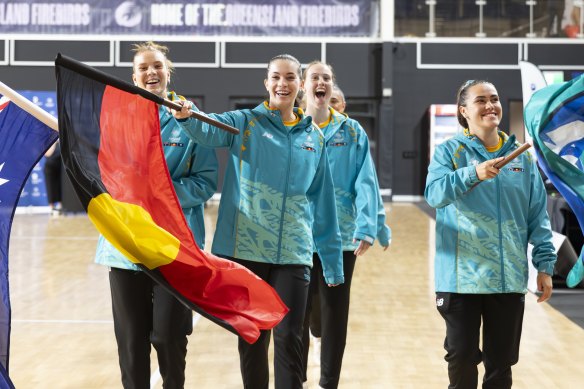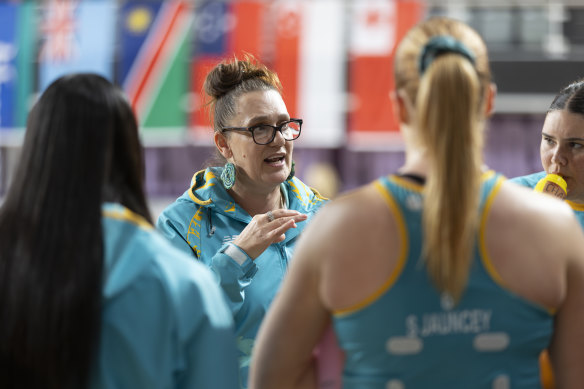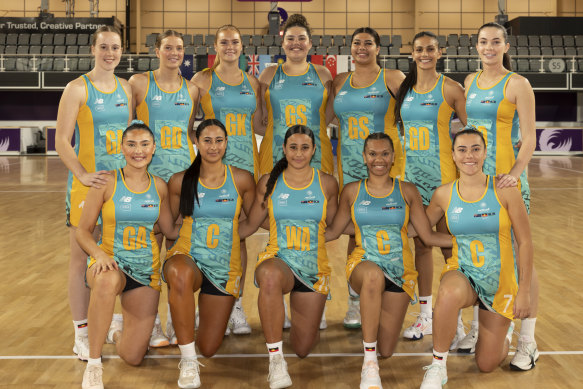Netball’s missing ‘Riolis’: Why the sport is searching for its hidden Indigenous talent
The netball equivalent of the talent of the Riolis, Longs and Wanganeens in the AFL men’s competition are out there, but have lacked the opportunities to break into the sport, according to Netball Australia’s First Nations engagement lead, Kamilaroi woman Ali Tucker-Munro.
This year, there are just two contracted First Nations players in Super Netball, Queensland Firebirds shooter and Noongar woman Donnell Wallam and Sunshine Coast Lightning mid-courter and Wakka Wakka woman Leesa Mi Mi. Gabby Coffey, a Wiradjuri woman, is a training partner with the Melbourne Vixens.

The Pacific Netball Series.Credit: Netball Australia
Tucker-Munro, a former Diamonds squad member, coached the Black Swans, the sport’s inaugural First Nations team earlier this year, which she said showcased that within a culturally safe and comfortable environment, a brand of netball from Indigenous players can thrive.
“It’s like our brand of football our mob can play, right? It’s very flaring, unique and athletic. And we want to make sure that, like our men in the AFL, we are also getting those same opportunities and the same recognition that the different style is actually to be celebrated and to be harnessed,” Tucker-Munro said.
“We know for a fact that we have the same depth of talent and skill set and athleticism as women because I’ve seen it over decades of getting out into community and coaching our kids and seeing it happening, but they just don’t break through.”
The team was created in part to help increase visibility to First Nations talent.
Another lever Netball Australia is pulling to improve pathways from community into the elite system is a pilot First Nations tournament, which will be held this September in Melbourne and feature an under-23 team from every state and territory across the country.
Part of bringing First Nations talent together under one roof, Tucker-Munro said, was to ensure Indigenous players coming through the pathways knew there were more players like them and build a sense of community.
“It’s not just providing a platform to incentivise these kids to continue on their journey, but I also think it’s a way in which those girls in the system are quite high up know that they’re not alone,” she said.
“These kids are out there doing the hard yards training every week, you know, sometimes twice a day, chasing their dreams. So to say that there’s only a Donnell or a Leesa, you know, there’s kids out there.

Kamilaroi woman and coach of the First Nations Black Swans, Ali Tucker-Munro. Credit: Barry Alsop / Eyes Wide Open Images
“And I think that’s the narrative we want to shift, but we also know that we’ve got a long way to go and that the first step is the hardest. And that’s what these programs this year have been about, is just taking that first step forward.”
The sport was forced to confront its relationship with Indigenous affairs, including having a shamefully low number of First Nations players and staff in its past, when in 2020 the league’s one and only Indigenous player was left off the court in Indigenous Round after being made its poster woman.
Queensland Firebirds and Wakka Wakka woman Jemma Mi Mi – sister of Leesa – spoke about the pressure of being the only Indigenous player in the Super Netball leading into that weekend and the responsibility she felt to be a positive role model, but was then benched to vast fan and community criticism.
Following this, the sport pledged a declaration of commitment to help break down the barriers preventing First Nations people from entering and reaching their potential.
“We know there’s so many talented First Nations netballers across Australia, and we know that they often don’t get opportunities given to them, for a range of reasons, and that’s not just purely because they lack the talent. I think there’s a lack of cultural literacy at times in the system, a lack of cultural awareness and understanding,” Tucker-Munro said.
“Our mob just want to be seen in the game, and that visibility and representation is really important.”
The pilot First Nations tournament is not just for the players but also to develop and nurture talent across the netball ecosystem, including coaches, umpires and support staff.
At present, there will be five or more Indigenous umpires, as well as past players as coaches.

Netball’s inaugural First Nations Black Swans team.Credit: Barry Alsop / Eyes Wide Open Images
“ We’re showing our community that there are these amazing people out there doing the hard yards in the system. Come and watch, come and have a yarn,” Tucker-Munro said.
“Talk through what the pathway is. Where’s the door to the pathway? How does it work? That’s what we want to do, really cultivate conversations but also build those connections. So having mob under one roof in Melbourne, all around Australia with a shared passion of netball... it’s a game-changer for this sport.”
News, results and expert analysis from the Olympics sent daily throughout the Games. Sign up for our Sport newsletter.